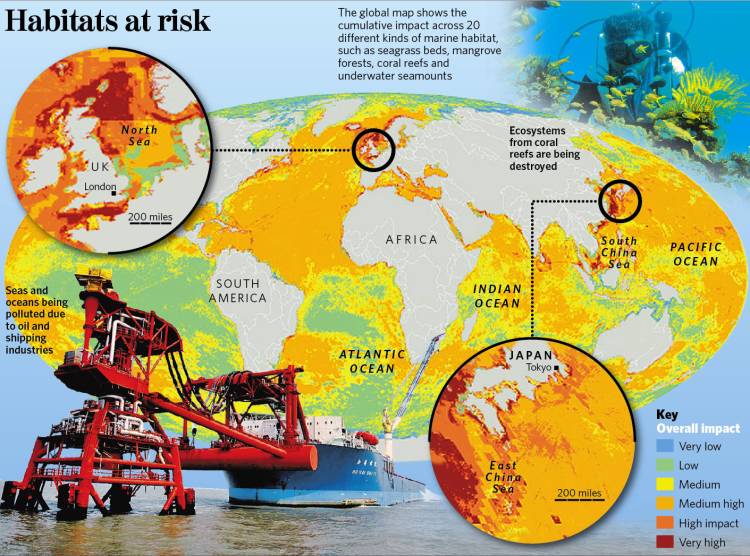Revealed: polluting impact of humans on the oceans

Almost every part of the world's oceans has been tainted to some extent by the destructive footprint of human activity, whether it is from overfishing and pollution or commercial shipping and coastal development.
For the first time, scientists have compiled a comprehensive map of the oceans showing the extent to which they have been damaged by man. The map integrates 17 different kinds of human activity – such as nitrogen fertilisers being washed into the sea from farming – and 20 types of ocean ecosystem, from coral reefs to mangrove forests, to study which parts of the marine environment have suffered most. The scientists found more than 40 per cent of the oceans bear the scars of serious environmental degradation and that only a small percentage have remained as pristine regions free of human influence.
The team of American scientists said the extent of the damage caused by man came as a shock although they believe the information they compiled could be used to improve the conservation and future protection of the marine environment.
The worst affected waters include large areas of the North Sea, the South and East China seas, the Caribbean Sea, the Atlantic off the east coast of North America, the Mediterranean, the Red Sea, the Bering Sea, parts of the western Pacific and the Persian Gulf.
Details of the study were presented yesterday to the American Association for the Advancement of Science in Boston by Ben Halpern of the University of California at Santa Barbara, who led the team of 19 experts from 16 different research centres.
"This project allows us to finally start to see the big picture of how humans are affecting the oceans. Our results show that, when these and other individual impacts are summed up, the big picture looks much worse than I imagine most people expected. It was certainly a surprise to me," Dr Halpern said.
"My hope is that our results serve as a wake-up call to better manage and protect our oceans rather than a reason to give up. Humans will always use the oceans for recreation, extraction of resources and for commercial activity such as shipping. That is a good thing. Our goal, and really our necessity, is to do this in a sustainable way so that our oceans remain in a healthy state and continue to provide use the resources we need and want."
The worst-affected marine ecosystems were coral reefs, nearly half of which have suffered badly, seagrass beds, mangrove forests in estuaries, underwater "mountain" ranges known as seamounts, rocky reefs and shallow continental shelves, especially those near densely populated areas, such as the North Sea.
"This study quantifies the extent of the problems marine scientists have long known to be issues," said John Bruno, a marine scientist at the University of North Carolina at Chapel Hill. "But it's not enough to just know something's a problem. If you want to do something about it you have to know where the problems are and what's causing them."
Ecological mapping in the past has tended to concentrate on one or two environmental factors covering areas with a resolution of 50 sq km. But the latest map integrates 17 aspects of global change, including warmer seas, to a resolution of 4 sq km.
Dr Bruno said: "This new database reveals for the first time the magnitude, geographic extent and precise locations of ocean warming. Armed with new information, the research team can begin to tackle the bigger problem of understanding and forecasting how ocean warming will affect marine ecosystems."
The scientists found that the most pristine oceans tended to be near the poles and there is concern about how they will be affected by future human activities brought about by the melting of polar sea ice, which enables ships to sail through larger areas of open water.
Data gathered for the global map could be used to bolster initiatives such as marine protected areas and ocean zoning which attempt to conserve the natural balance of ecosystems against human activity.
Dr Halpern said: "There is definitely room for hope. With targeted efforts to protect the chunks of the ocean that remain relatively pristine, we have a good chance of preserving these areas in good condition."
Elizabeth Selig of North Carolina University, a member of the research team, added: "This information enables us to tailor strategies and set priorities for the management of ecosystems. And it shows that while local efforts are important, we also need to be thinking about global solutions."
Join our commenting forum
Join thought-provoking conversations, follow other Independent readers and see their replies
Comments